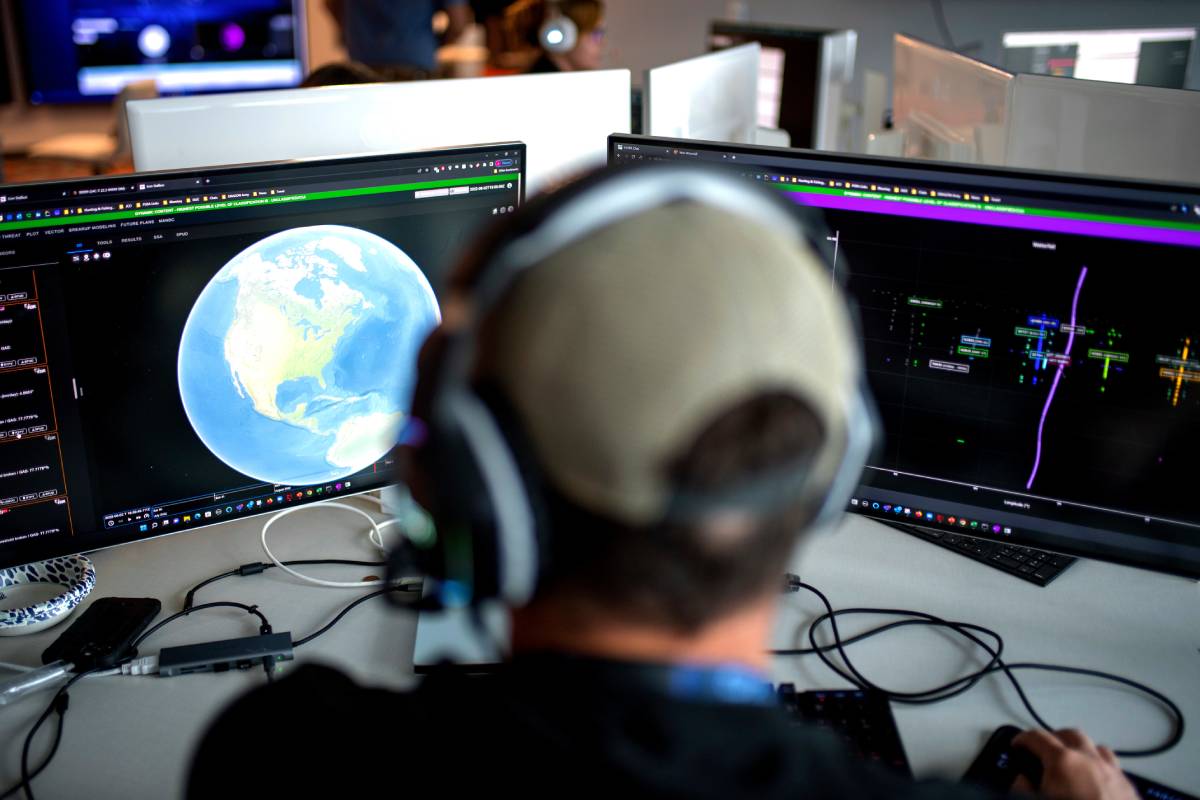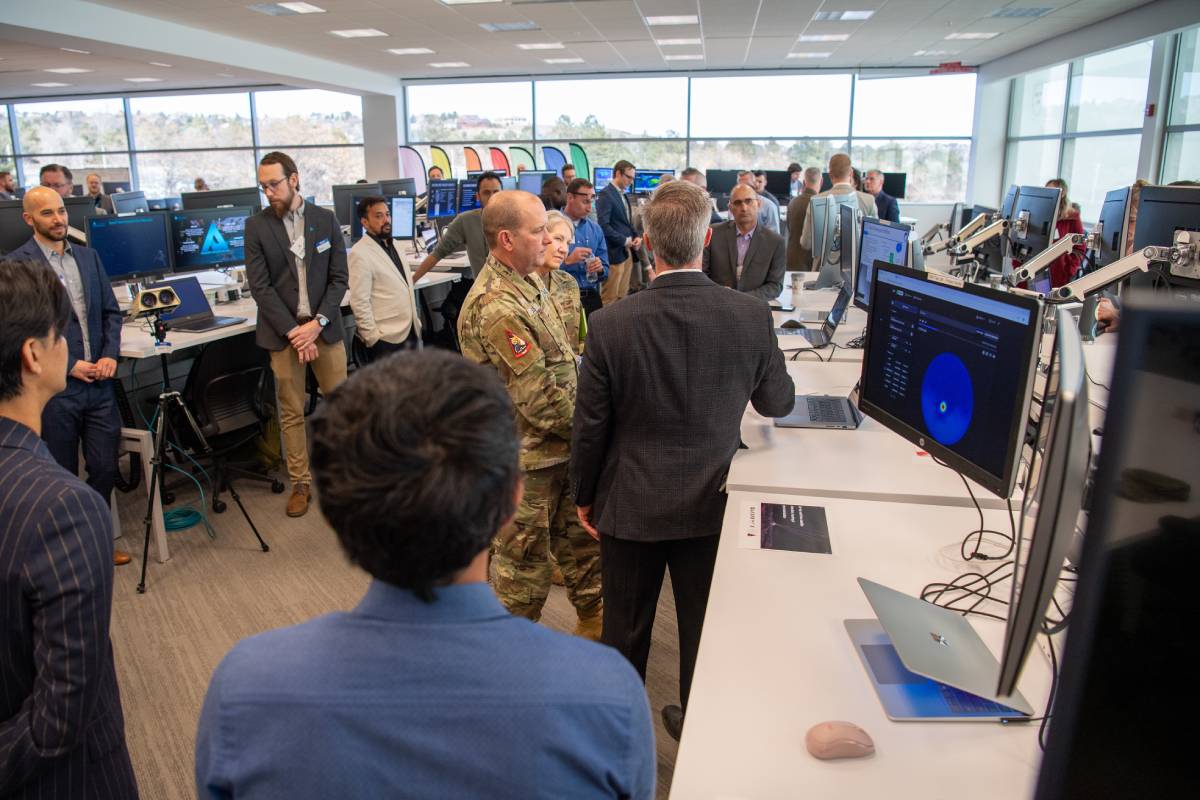 U.S. Space Force Chief of Space Operations Gen. Chance Saltzman delivers a keynote address at the 40th Space Symposium in Colorado Springs, Colo., April 9, 2025. (Source: Space Foundation)
U.S. Space Force Chief of Space Operations Gen. Chance Saltzman delivers a keynote address at the 40th Space Symposium in Colorado Springs, Colo., April 9, 2025. (Source: Space Foundation)
COLORADO SPRINGS, Colo. — In the foyer of U.S. Space Systems Command (SSC) headquarters at Schriever Space Complex, a clock ticks down the hours and minutes to 2026. That’s the timeframe Space Force leaders set for acquiring and delivering the capabilities to stay ahead of threats from peer and near-peer adversaries in space.
Achieving that mission requires timely, actionable space domain awareness (SDA)—to detect, characterize, track and predict threats—as well as the ability to share that information securely among diverse stakeholders. Delivering against the 2026 timeline requires new forms of engagement with commercial stakeholders.
Programs to integrate space domain awareness data and distribute it across classification levels have been gaining speed. Though much work remains, many of these programs are beginning to find an operational rhythm, reflecting the urgency of the mission.
“I’ve said it before and I’ll say it again: Space power is the ultimate team sport,” said Chief of Space Operations Gen. Chance Saltzman at this year’s Space Symposium. “Without cooperation, we will not be able to achieve our objectives as rapidly and effectively as the security environment demands.”
 James Kirby, deputy site lead with the Joint Commercial Operations cell (JCO) participates in a training cycle in Colorado Springs, Colo, Aug. 2, 2022. (Source: USSF/Tiana Williams)
James Kirby, deputy site lead with the Joint Commercial Operations cell (JCO) participates in a training cycle in Colorado Springs, Colo, Aug. 2, 2022. (Source: USSF/Tiana Williams)
CIC: Classified, Operational Information Sharing
U.S. Space Command’s (SPACECOM) Space Force-Space (S4S) oversees two of the most active components for integrating and operationalizing commercial SDA capabilities: the Joint Commercial Operations (JCO) cell and the Commercial Integration Cell (CIC).
Located at Vandenberg Space Force Base in California, CIC works with select vendors to exchange classified (SCI) operational information and technology. Beginning in late 2024, the CIC expanded its traditional partnerships with satellite owners and operators to companies involved in the SDA mission and tactical surveillance, reconnaissance and tracking (TacSRT). What started as a group of 10 has expanded to 17, including, BlackSky, Eutelsat America, Hughes Network Systems, Iceye US, Intelsat General Communications, Iridium Communications, Kratos, LeoLabs, Maxar Intelligence, SES Space & Defense, SpaceX, Telesat, Viasat and XTAR. According to recent announcements, CIC will further expand information sharing to National Reconnaissance Office (NRO) contractors.
Beyond classified briefs, CIC companies are represented on the Combined Space Operations Center (CSpOC) operations floor, receiving high-level threat information and have a direct line for feedback to the government.
Lt. Gen. Douglass Schiess, Commander of S4S and Combined Joint Space Force Component, cited a recent CIC success where a member company provided the first indication of a satellite breakup. “What normally takes 24-48 hours to announce … we were able to do that within about six to eight hours,” he said. “We couldn’t have done that without the interaction with our Commercial Integration Cell.”
JCO: Non-Classified Distribution
Unlike CIC, the Joint Commercial Operations (JCO) cell, at the National Space Defense Center in Colorado Springs, provides non-classified data, tools and analytics in what amounts to a breakthrough in information and threat sharing with commercial and international partners. According to officials, 18 nations plus NATO are accessing commercial SDA data through the JCO, which has 17 commercial partners.
Todd Gossett, VP of Space and National Security Initiatives for SES Space & Defense, a global satellite operator and member of the CIC, noted the benefits of the JCO during a Space Symposium discussion on commercial integration. As a CIC member, he was cleared to receive indications and warnings at the top-secret level, but he couldn’t share those with non-U.S. colleagues at his company, he explained. With JCO, some of that information is now flowing to operators and allies outside the United States.
“That’s a big win,” Gossett said. “And that helps us understand what’s going on in the environment.”
The improvements of SDA data sharing have been built largely on the shoulders of the Unified Data Library (UDL), a centralized, cloud-based repository with various sensor data in standardized data formats. UDL data comes from contributors across civil, commercial and non-classified national security space, academia as well as from partner nations contributing non-classified sensor and analytics data. That data is incorporated into the JCO and other programs to support innovation and test environments, such as the Space Domain Awareness Tactical Applications Proving Lab (SDA TAP Lab).
SDA TAP Lab: A Playground for Innovation
Located in Colorado Springs, the SDA TAP Lab was stood up in 2023 under then-SSC Commander (now Vice Chief of Space Operations) Gen. Michael Guetlein as a place for industry, academia and government to solve critical problems and close gaps in the space defense architecture.
 Lt. Gen. Douglas A. Schiess, U.S. Space Forces – Space (S4S) commander and Combined Joint Force Space Component Commander (CJFSCC) and USSF Chief Master Sgt. Tina Timmerman, S4S senior enlisted leader, visit Space System Command’s Space Domain Awareness TAP Lab facility in Colorado Springs, Colo., Jan. 29, 2025. (Source: USSF/Tiana Williams)
Lt. Gen. Douglas A. Schiess, U.S. Space Forces – Space (S4S) commander and Combined Joint Force Space Component Commander (CJFSCC) and USSF Chief Master Sgt. Tina Timmerman, S4S senior enlisted leader, visit Space System Command’s Space Domain Awareness TAP Lab facility in Colorado Springs, Colo., Jan. 29, 2025. (Source: USSF/Tiana Williams)
More recently, Guetlein described the TAP Lab as a kind of playground to engage with SDA data and tackle diverse problem sets. “Please, bring your innovation. Come play with the data and see what you can do with it,” he said. “We want your innovation. I cannot hire enough cyber experts, network experts, data experts, IT experts to solve my problems. I need to really rely on innovation coming out of industry.”
Participants from industry or academia can get access to raw or processed data, support from staff and an open area to innovate, Guetlein continued. “And if you provide a capability that provides support to the warfighter, we will immediately pave you a path to the operational floor.”
To focus the efforts, the government has laid out a set of SDA problem statements ranked by criticality. For example: “Using commercial or public imagery, detect the start of a space launch cycle automatically.” Or: “Using orbital data, automatically detect proximity events between satellite pairs.” Through its Apollo Accelerator, which concentrates problem-solving efforts in three-month cycles, cohorts work collaboratively to showcase and combine their unique capabilities in responding to challenging scenarios. The next Apollo Accelerator is scheduled from May through July 2025.
Orbital Watch: Increasing Information Access
More recently, SSC announced Orbital Watch, a program to share threat information with hundreds of vendors across different classifications. The program is geared toward companies registered through the Front Door initiative, SSC’s first point of contact for small or nontraditional defense companies who want to engage Space Force.
“We have over 800 vendors that have come through the Front Door,” said Col. Richard Kniseley, head of SSC’s Commercial Space Office, during a Space Symposium panel. “It was important for us to also have a threat sharing capability for them—those that haven’t had the ability to go get a CAC Card or don’t have the clearances just yet.”
Orbital Watch launched in March and has started providing its first threat-sharing reports. Officials plan to release information quarterly with the goal of increasing the frequency and developing a commercial portal for two-way information sharing and real-time assessments.
AXE: Feeding International Partnerships
U.S. restrictions on information sharing with its international partners have been a regular obstacle to U.S.-international collaboration. Addressing the Space Force’s new International Partnership Strategy, Gen. Saltzman expressed frustration with the ability to share with allies. “We need to go faster and shift from a mindset of ‘need to know’ to one of ‘need to share,’” he said.
One of ways the service is moving in that direction is through SSC’s Allied Exchange Environment (AXE), a common data platform for real-time, two-way data distribution between select partners. Once fully developed, AXE will create a standardized interface between U.S. and international partners to eliminate current bottlenecks in how allies share on-orbit threat information. Through machine-to-machine data sharing, they will soon be able to access real-time information from the Secret UDL that is currently unavailable to non-U.S. entities.
Against the backdrop of a ticking countdown clock and an increasingly complex threat environment, cooperation and integration are more important than ever. To that end, industry and government continue making progress in reducing classification barriers, creating shareable datasets and common interfaces, and clearing the way for better space domain awareness.
Explore More:
Podcast: Innovative Commercial Solutions, Expanding CASR and Accelerating Space Readiness
Open-Source Intelligence Is a Key Ingredient of Holistic SDA
Data Fusion Leverages All Datasets for Better SDA
Podcast: Tracking Objects, Commercial Solutions and Emerging SSA Markets
